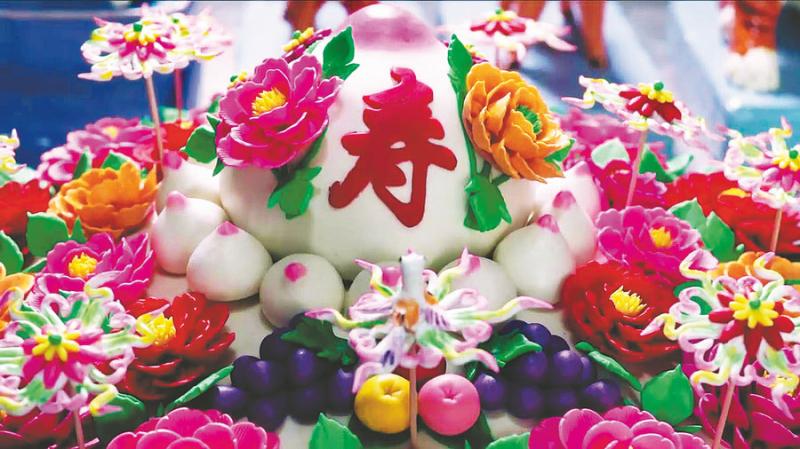Tasty tradition is sweet success for culture
Tasty tradition is sweet success for culture

Wenxi people roll out huamo for celebrations or major events to entertain guests for auspicious outcomes. [Photo provided to China Daily]
Flower-shaped buns have a proud heritage and look set for an appetizing future, Yang Feiyue and Sun Ruisheng report in Taiyuan.
Seen from afar, they are decorative polychromatic flowers, placed front and center at dining tables to feast the eyes.
Yet, these are different. After guests take their seats, they reach for them and start to dig in.
These flour and flower-shaped buns, or huamo , can be traced back to the Ming (1368-1644) and Qing (1644-1911) dynasties.
Whenever celebrations or major events take place, people in Wenxi county, North China's Shanxi province, roll out huamo to entertain guests for auspicious outcomes in the future.
The flour feat and treat has been known for its exquisite design and ingenious conception. It is closely related to local etiquette and customs and widely used in festivals, weddings, birthdays, funerals, housewarming and many other occasions.
"I grew up watching my grandmother and mother knead the flower-shaped buns on the bed with their legs crossed," says Zhi Jiankang, a provincial inheritor of the skill that was named a national intangible cultural heritage in 2008.
"I learned to make it after watching them."
Wenxi huamo has evolved into four categories with more than 200 varieties over the years.
"It takes a few people two days to make a large flower pattern," Zhi says.
The dough is leavened on the first day, and is kneaded into various shapes and sizes after a night of fermentation before being left to sit still for another night.
"When fermentation is completed, the buns are steamed and then colored with fruit and vegetable juice," Zhi explains.
For some major events, various "bun flowers" would then be assembled.
The importance of huamo is evident in a local proverb: "if something big happens, there is huamo ; if huamo is served, something must have happened."
Local families will steam the flowery buns to celebrate births of children to wish them good health, and dragon or phoenix patterns will be fashioned amid "bun flowers" during weddings to herald progeny.
"Wenxi flower-shaped buns present a variety of forms, and are always closely connected to local folk culture," Zhi says.
Different from traditional dough modeling that is mostly just for artistic appreciation, huamo will be eaten by guests after serving their symbolic purpose.

Zhi Jiankang (second from left) explains the huamo making process. [Photo provided to China Daily]
Many Wenxi huamo works are ingeniously crafted by local women through kneading. In the vast rural areas of the county, women pass their skills to their daughters.
They seem to work magic on the plain-looking dough through pinching, cutting, repairing, sticking and embellishing with common household utensils, such as needles, combs, knives, and shears. Consequently, the bun craft has also been affectionately called "mother's art".
"It reflects Wenxi working women's deep folk art knowledge in their lives over the long course of history," Zhi says, adding that it was all hands on deck for making huamo in his family during major holidays throughout his childhood.
"It has long been part of my life."
However, with the development of the times, young women are no longer keen on steaming buns. The art of the flowery bun, which has always been the pride of local rural households, faces a crisis.
Zhi has tried to revive the ancient art.
"That was when I seriously started to bond with huamo ," Zhi says.
Although huamo had been named a provincial intangible cultural heritage, authorities set their sights on restoring the influence it had once enjoyed.
In 2006, Zhi worked with local officials and found a 70-year-old village woman had huamo down pat, and filmed her making the traditional food.
"We recorded all the 12 steps from processing wheat, grinding flour to kneading and pinching dough, as well as steaming and coloring in her house," Zhi recalls.
The 15-minute film, introducing Wenxi huamo , created a national sensation.
From that moment on, huamo made its presence felt across the land. It made its way to a national intangible heritage culture exhibition in Beijing in February 2009, and the World Expo 2010 in Shanghai, as well as overseas.
Although exhausted, Zhi says it is worth it when the culture of his hometown is appreciated by guests from across the country and beyond.
During Spring Festival in 2012, Wenxi held a huamo cultural festival. More than 300 villages from the county sent more than 2,000 pieces of huamo , some of which were named the biggest or tallest of their kind by the Hong Kong-based World Record Association.
After the festival, the county authorities supported huamo cooperatives and the registration of huamo trademarks, giving further impetus for the development of the intangible culture.
"I felt the era of the Wenxi huamo had finally arrived," says Zhang Haiyun, a local who has been deeply attracted to huamo under the influence of her mother and grandmother.
"At 10, when my mother and grandmother were making huamo , I would be allowed to pinch the dough," the 41-year-old recalls.
"It was more for self-indulgent fun, but I guess learning also happened in a subtle way."
In 2005, Zhang's sharp business acumen had her register the Beiyuan Bun trademark in the local area.
"I thought of developing the traditional handicraft into an industry when I realized it had such a long history," she says.
Then, the 2012 festival urged her to materialize her ambition.
"I was surprised to find that we could make so many things out of flour at the festival, so I made an immediate decision to set up a company that specializes in making huamo ," she says.

Huamo can be presented in various forms, such as flowers and tigers. [Photo provided to China Daily]
Unlike the traditional family-based huamo production, Zhang's huamo products have been injected with fresh elements.
In Zhang's store, a bunch of colorful and lifelike bright and golden "roses" are particularly eye-catching.
"This is our new design, very popular with young people, and the sales have been especially brisk," Zhang says.
Her business now not only undertakes traditional huamo production, but also caters to modern consumer demand for a variety of novel patterns, such as hand-held flowers, potted plants, calligraphy and paintings.
" Huamo has to go through innovations to keep up with the beat of modern life," Zhang explains.
After the company was established, Zhang and her team produced a bun featuring the Chinese character shou, meaning longevity.
"We saw a picture of the word in a painting from the Qing Dynasty, and thought the symbolism was particularly good, so we used huamo to present it."
The product is one meter wide and 1.5 meters tall and has been popular with customers who want to celebrate birthdays of the elderly.
Zhang has found that huamo has also made its way to the high-end market as a business gift, since it can be made into pure artwork that can last for seven or eight years.
At present, her company has employed more than 20 locals who engage in marketing, product development and processing.
"The youngest are in their 20s and the oldest is 70, and the inheritance of skills is completed in the workshop," Zhang says.
At present, there are two large huamo enterprises and 12 cooperatives in Wenxi, with more than 1,000 locals involved.
The annual output value has reached 10 million yuan ($1.38 million), according to local authorities.
This year, Zhang has put together a livestream team, with an eye to promoting the "mother's art" across the country.
"It's my wish that huamo could claim just as much place as cake does during our traditional festivals," Zhang says.
Peng Ke'er contributed to this story.

Huamo can be presented in various forms, such as flowers and tigers. [Photo provided to China Daily]
.

Huamo can be presented in various forms, such as flowers and tigers. [Photo provided to China Daily]
Tags
Who is online
36 visitors



Every week I post an article about a different creative art when A.Mac closes the weekend article - this time it is something that is not only a creative art, but a delicious one as well.
I've seen some complicated and delicious artwork and it only gets more creative.
This presentation has been in good taste.
Yum Buzz.